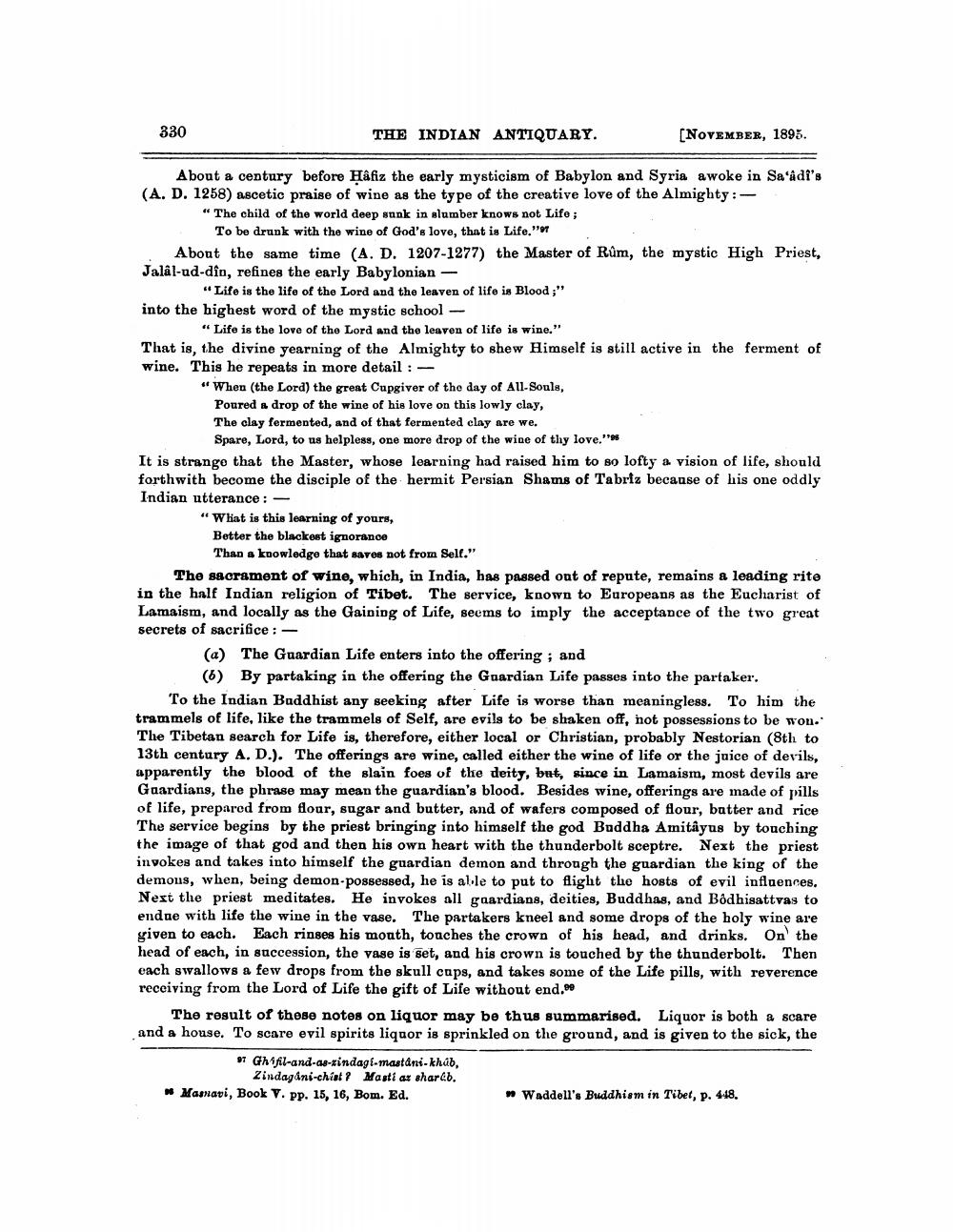________________
330
THE INDIAN ANTIQUARY.
[NOVEMBER, 1895.
About a century before Hafiz the early mysticism of Babylon and Syria awoke in Saadi's (A. D. 1258) ascetic praise of wine as the type of the creative love of the Almighty:
"The child of the world deep sunk in slumber knows not Life;
To be drunk with the wine of God's love, that is Life." About the same time (A. D. 1207-1277) the Master of Rům, the mystic High Priest, Jalâl-ud-din, refines the early Babylonian -
"Life is the life of the Lord and the leaven of life is Blood;" into the highest word of the mystic school -
"Life is the love of the Lord and the leaven of life is wine." That is, the divine yearning of the Almighty to shew Himself is still active in the ferment of wine. This he repeats in more detail:
"When the Lord) the great Cupgiver of the day of All-Souls,
Poured a drop of the wine of his love on this lowly clay, The clay fermented, and of that fermented clay are we.
Spare, Lord, to us helpless, one more drop of the wine of thy love." It is strange that the Master, whose learning had raised him to so lofty a vision of life, should forthwith become the disciple of the hermit Persian Shams of Tabriz because of his one oddly Indian utterance: -
“What is this learning of yours, Better the blackest ignorance
Than & knowledge that saves not from Sell." The sacrament of wine, which, in India, has passed out of repute, remains a leading rite in the half Indian religion of Tibet. The service, known to Europeans as the Eucharist of Lamaism, and locally as the Gaining of Life, seems to imply the acceptance of the two great secrets of sacrifice : -
(a) The Guardian Life enters into the offering; and
(6) By partaking in the offering the Guardian Life passes into the partaker. To the Indian Baddhist any seeking after Life is worse than meaningless. To him the trammels of life, like the trammels of Self, are evils to be shaken off, not possessions to be won. The Tibetan search for Life is, therefore, either local or Christian, probably Nestorian (8th to 13th century A.D.). The offerings are wine, called either the wine of life or the juice of devils, apparently the blood of the slain foes of the deity, but, since in Lamaism, most devils are Guardians, the phrase may mean the guardian's blood. Besides wine, offerings are made of pills of life, prepared from flour, sugar and butter, and of wafers composed of flour, butter and rice The service begins by the priest bringing into himself the god Buddha Amitayus by touching the image of that god and then his own heart with the thunderbolt sceptre. Next the priest invokes and takes into himself the guardian demon and through the guardian the king of the demous, when, being demon-possessed, he is able to put to flight the hosts of evil influences. Next the priest meditates. He invokes all goardians, deities, Buddhas, and Bodhisattvas to endae with life the wine in the vase. The partakers kneel and some drops of the holy wine are yiven to each. Each rinses his mouth, touches the crown of his head, and drinks. On the head of each, in succession, the vase is set, and his crown is touched by the thunderbolt. Then each swallows a few drops from the skull caps, and takes some of the Life pills, with reverence receiving from the Lord of Life the gift of Life without end."
The result of those notes on liquor may be thus summarised. Liquor is both a scare and a house. To scare evil spirits liquor is sprinkled on the ground, and is given to the sick, the
97 Ghi fil-and-as-zindagi-mastani-khúb,
Zindagini-chiat? Masti ar shareb, * Masnavi, Book V. pp. 15, 16, Bom. Ed.
n Waddell's Buddhism in Tibet, p. 448.




